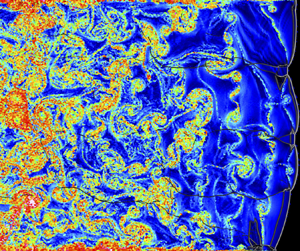Article contents
Lagrangian dispersion and averaging behind a two-dimensional gaseous detonation front
Published online by Cambridge University Press: 08 August 2023
Abstract

Two-dimensional numerical simulations with the particle tracking method were conducted to analyse the dispersion behind the detonation front and its mean structure. The mixtures were 2H $_2$–O
$_2$–O $_2$–7Ar and 2H
$_2$–7Ar and 2H $_2$–O
$_2$–O $_2$ of increased irregularity in ambient conditions. The detonation could be described as a two-scale phenomenon, especially for the unstable case. The first scale is related to the main heat release zone, and the second where some classical laws of turbulence remain relevant. The dispersion of the particles was promoted by the fluctuations of the leading shock and its curvature, the presence of the reaction front, and to a lesser extent transverse waves, jets and vortex motion. Indeed, the dispersion and the relative dispersion could be scaled using the reduced activation energy and the
$_2$ of increased irregularity in ambient conditions. The detonation could be described as a two-scale phenomenon, especially for the unstable case. The first scale is related to the main heat release zone, and the second where some classical laws of turbulence remain relevant. The dispersion of the particles was promoted by the fluctuations of the leading shock and its curvature, the presence of the reaction front, and to a lesser extent transverse waves, jets and vortex motion. Indeed, the dispersion and the relative dispersion could be scaled using the reduced activation energy and the  $\chi$ parameter, respectively, suggesting that the main mechanism driving the dispersion came from the one-dimensional leading shock fluctuations and heat release. The dispersion within the induction time scale was closely related to the cellular structure, particles accumulating along the trajectory of the triple points. Then, after a transient where the fading transverse waves and the vortical motions coming from jets and slip lines were present, the relative dispersion relaxed towards a Richardson–Obukhov regime, especially for the unstable case. Two new Lagrangian Favre average procedures for the gaseous detonation in the instantaneous shock frame were proposed and the mean profiles were compared with those from Eulerian procedure. The characteristic lengths for the detonation were similar, meaning that the Eulerian procedure gave the mean structure with a reasonable accuracy.
$\chi$ parameter, respectively, suggesting that the main mechanism driving the dispersion came from the one-dimensional leading shock fluctuations and heat release. The dispersion within the induction time scale was closely related to the cellular structure, particles accumulating along the trajectory of the triple points. Then, after a transient where the fading transverse waves and the vortical motions coming from jets and slip lines were present, the relative dispersion relaxed towards a Richardson–Obukhov regime, especially for the unstable case. Two new Lagrangian Favre average procedures for the gaseous detonation in the instantaneous shock frame were proposed and the mean profiles were compared with those from Eulerian procedure. The characteristic lengths for the detonation were similar, meaning that the Eulerian procedure gave the mean structure with a reasonable accuracy.
JFM classification
- Type
- JFM Papers
- Information
- Copyright
- © The Author(s), 2023. Published by Cambridge University Press
References
- 7
- Cited by



